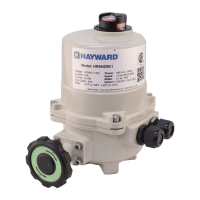USE ONLY HAYWARD GENUINE REPLACEMENT PARTS
HRSLCSSPLMNTIOM Rev A
Page 16 of 42
Hayward Flow Control
1-888-HAY-INDL (1-888-429-4635)
www.haywardowcontrol.com
Notice: The end stop travel (cams) of this actuator have been factory set and tested to respond between 0° and
90° degrees rotation. If NO changes to end stops are required, this unit is ready to be put into service immediately
using this procedure. IF changes to the cam positions are required, refer to the product IOM before proceeding.
Conceptually this procedure rst establishes correct direction and control; these MUST be veried in order to
proceed. Regardless of the Level of the actuator, the actuator must drive CW when commanded to do so, and
STOP when the actuator reaches the full CW travel position. The same applies for the CCW operation.
Calibration Procedure - CK Series Proportional Control
1. Set the control signal selection jumpers, refer to the Actuator IOM Proportional PCB detail page.
2. Before applying power, verify that the voltage feeding the actuator is the same as the rating of the actuator.
Proceed after conrmation is made.
3. Place the LCS Mode switch in the OFF position, and apply power.
A. A. The white Power indicator on the face of the LCS should illuminate.
I. Note that the MODE switch is NOT a power disconnect.
B. The actuator should NOT move.
I. If it does, IMMEDIATELY remove power from the actuator to STOP movement.
II. Check control wiring (Reference the Actuator IOM). Correct if necessary, and repeat step 3.
4. Generate a mid-travel command (12mA) then place the LCS Mode switch in the REMOTE position.
A. The actuator should move only to match the incoming signal, if at all.
I. If the actuator moves and continues to move away from midpoint, IMMEDIATELY remove power from
the actuator to STOP movement.
• Place a meter in series with terminal 3 (ref) and the wire coming from the eld controller
(+), it MUST read +12mA.
• If it does NOT, check the polarity of the incoming analog signal to make sure it is
(+)12mA. Repeat step 4.
II. If the actuator moves momentarily and then STOPS at the mid stroke position, proceed to step 5.
III. If the actuator does not move at all, rotate the handwheel slightly in either direction to offset the controller
• The actuator should move back to the midpoint position and then STOP. Proceed to
step 5.
5. Generate a CW move command (4mA) and verify the DIRECTION of rotation of the position indicator is CW.
A. The actuator should run CW and run until it reaches its CW end of travel position.
B. While power is on, an analog feedback signal OUT provides an electronic position of the actuator... i.e. 4mA =
full CW and 20mA = full CCW positions (reference terminals #5 (+) and #6 (-) ).
C. On HRCK3A~4F units with torque switches, during CW travel movement, depress the lever on the UPPER
torque switch to interrupt actuator movement as a check of the system.
D. On HRCK5A~6A units with torque switches, during CW travel movement, depress the lever on the LOWER
torque switch to interrupt actuator movement as a check of the system.
WARNING – Follow these directions carefully and in order. Actuator damage due to improper testing and
commissioning will NOT be covered under warranty.
CAUTION – This procedure has many sections with the text “IMMEDIATELY remove power from the actuator to
STOP movement”. Quick action is necessary in case of any unexpected or uncontrolled movement to keep the actuator
from possibly driving into the mechanical stops, past the limits of the valve or damper attached, and to simply keep the
actuator in a known position for a quick, efcient installation.
LCS CALIBRATION AND COMMISSIONING
HRCK PROPORTIONAL CONTROL
Back to TOC

